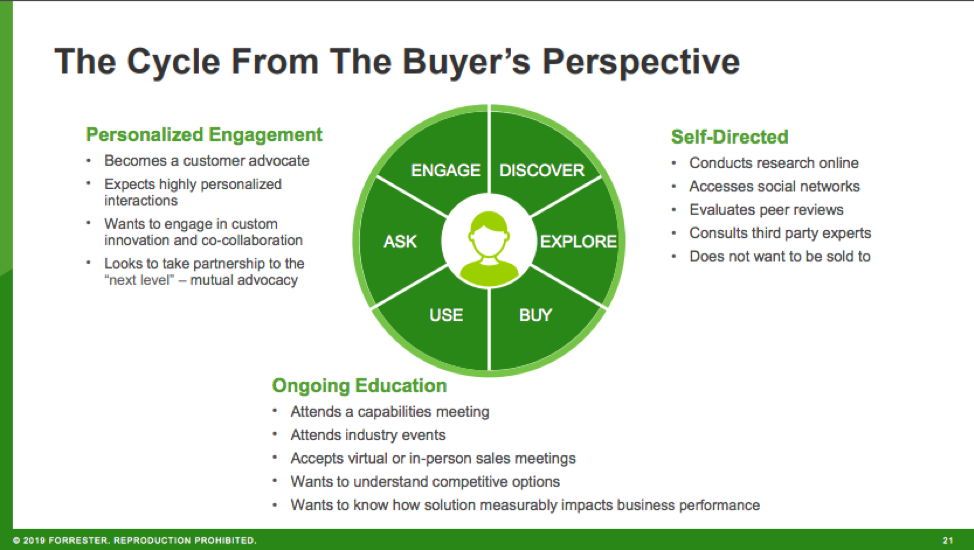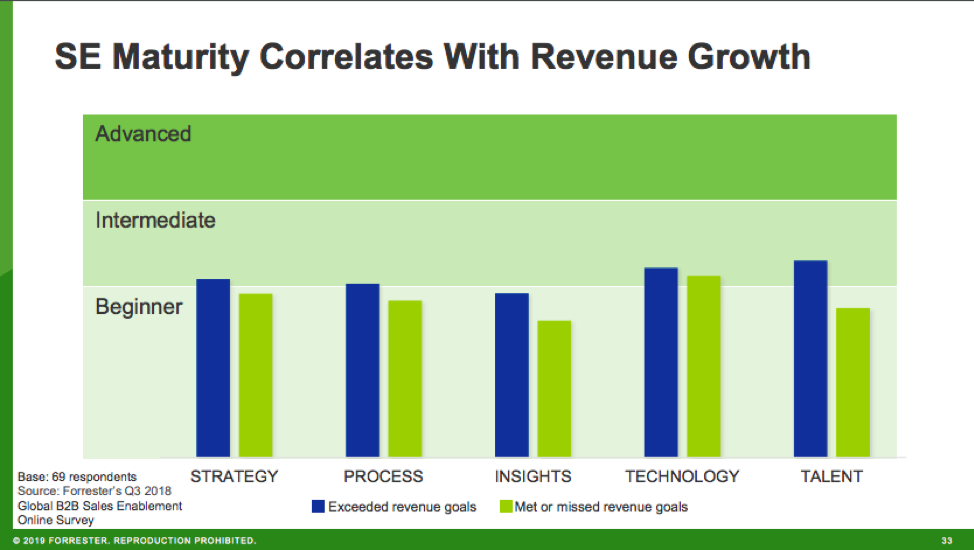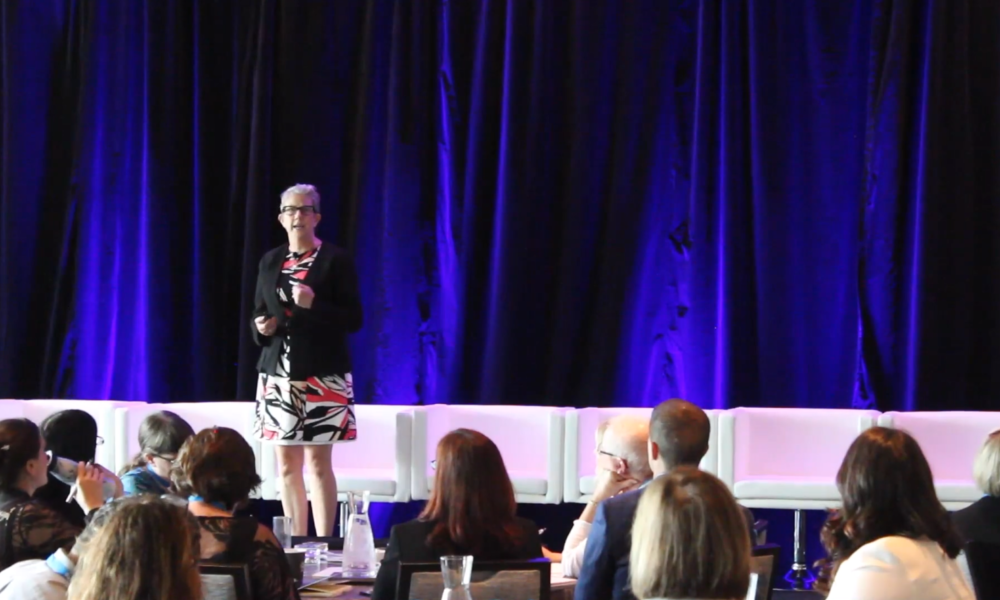Elevating the Impact of Sales Enablement
3.9K Views | 11 Min Read
Never before has a discipline ascended so quickly to a strategic business function than sales enablement. Initially a “fixer” of broken business efforts, sales enablement is now table-stakes for businesses to improve performance.
This rapid growth is driven by the fact that sales enablement and its efforts are tightly wound to both revenue and the customer experience. One might argue that sales enablement is one of the most well-positioned business functions to implement the change required to improve both.
“I think we are at a critical juncture with sales enablement,” said Mary Shea, principal analyst at Forrester Research. “We are at a place where this discipline is more critical than ever before, especially for organizations that want to put their sellers on even footing with buyers, and for organizations that want to deliver a world-class buyer-customer experience.”
With this potential for impact in mind, companies need to elevate the importance of sales enablement within the organization. In doing so, organizations will ensure they provide modern, buyer-centric, and interconnected buying experiences that stretch far beyond the sales team.
The Growing Need for Sales Enablement
To understand why sales enablement is so critical, one must first understand the challenges companies face in modernizing sales practices to keep up with fast-changing buying landscapes. Here are five core macro trends impacting the sales ecosystem:
- Holistic Buyer Experiences: Innovations of the past such as CRM and marketing automation were small steps towards bringing buyers and sellers together and automating sales activities, but neither fully succeeded in creating the quintessential buyer experience. Sales enablement is poised to succeed where these tools fell short by providing guidance to sellers on when and how to effectively engage buyers throughout their buying journey.
- Integration of Artificial Intelligence: AI is pervasive and growing more sophisticated in all areas of business. As it continues to expand its capabilities, AI is changing the entire sales ecosystem by providing sellers with more intelligence on how to effectively engage buyers.
- Consumerization of the B2B Buyer: The behaviors, attitudes, and expectations of business and consumer buyers are starting to converge, as B2B buyers now develop a strong sense of brand loyalty due to a rising focus on customer experience. These buyers are continuously raising their expectations for every interaction; they want meaningful, value-oriented, personalized connections and experiences. Similar to the consumer expectations of brands like Amazon or Spotify, B2B buyers are demanding predictive recommendations on what information to look at and when.
- Increasing Demand for Adaptability: Buyers are continuing to evolve at breakneck pace, and the selling ecosystem needs to evolve and change at the same rate. Sales must adapt in real-time based on data inputs from a host of different sales tools and systems in use. For example, this might mean jumping in quickly to course-correct if sales management isn’t tracking to revenue with an initiative to keep buyers engaged.
- Evolving Buyer/Seller Dynamics: The seller is no longer the primary conduit of a company’s information. In fact, 68% of B2B buyers prefer to research online, up 15% from just three years ago. Additionally, 60% of buyers prefer not to interact with the sales rep as their primary source of information. While they still want to engage and interact with sellers, they prefer finding new primary sources and don’t want to hear what they’ve already learned. Another 62% say they can develop selection criteria or finalize a vendor list based solely on digital content, meaning that without an effective digital content strategy tightly linked to seller activity, some companies won’t even be in the conversation.
The Future of Sales Enablement in an Evolving Ecosystem
Buyers want to interact with sellers in different, more impactful ways than they have historically. They don’t want to have conversations about product, pitches, and price; they want to learn something new from their seller. Buyers are going to gravitate toward sellers who weave in customized data and insights, are dynamic and flexible, and collaborative. When sellers exhibit these behaviors, buyers are 74% to 77% more likely to buy from them.
“You really have the opportunity as enablers to put yourselves and your companies in a position where you are going to get chosen more often than not, but you can’t do it by going to market in the same way that you’ve always done it,” said Shea. “You’ve got to make sure you have the right tools, processes, and methods to arm your sellers to engage in this type of fashion.”
Adapting to this new ecosystem means companies must go beyond simply implementing sales enablement: Driving top-line growth means taking specific, measured steps towards maturing sales enablement programs. Here are three ways companies can elevate their sales enablement function.
Defining Sales Enablement
While some organizations are hustling to establish sales enablement, organizations with it in place are only now beginning to modernize their approaches. As enthusiasm and excitement grow, budgets have been increasing across industries for both sales tools and sales enablement.
However, companies still do not have a unified, working definition for sales enablement. As the field evolves, it is important that companies establish clear definitions of what sales enablement does and is responsible for within the business to maximize impact.
Forrester Research understands sales enablement as the following: a business function that helps all selling systems work in an effective, efficient, and coordinated manner in order to increase revenue lift, minimize costs associated with sales, and deliver more meaningful experiences to buyers.
From there it can be broken down into the three E’s: efficiency, effectiveness, and experience. Efficiency is the ability of the sales team to drive revenue, effectiveness means personalizing and tailoring every individual interaction, and experience streamlines the whole process across buyers, sellers, and marketers.
Whether organizations adopt a similar definition of sales enablement or one of their own, it is essential for organizations to put a stake in the ground and determine what sales enablement means to drive business transformation.
Embracing the Seller of Tomorrow
Salespeople have often carried concern that technology advancements may one day render them unnecessary. But human interaction will continue to be valuable even as technology advances. Armed with new tools and technologies, sellers will be able to spend less time downstream and instead focus on high-value activities.
Rather than new technologies marginalizing the seller’s importance altogether, sellers will now play new, essential roles that are fundamentally different than in the past. Specifically, modern B2B sellers need to possess six key traits:
- Engage in networked selling
- Embrace multiple social channels
- Share new ideas
- Leverage digital tools
- Prefer collaboration
- Turn data into insights
Sales enablement will play a critical role in helping to ease and nurture this transition by instilling these skills in sellers.
Focusing on Buyer-Centricity
Sales enablement should look at the sales cycle through a buyer-centric lens. From the buyer’s perspective, the sales cycle includes three phases: self-directed, ongoing education, and personalized engagement.

- Self-directed: buyers conduct research online, assess social networks, evaluate peer review sites, and consult experts. By a factor of three to one, they do not want to be sold to during this stage. Sellers need to allow the buyer to go their own way, while inserting themselves in the process to complement and amplify the buyer’s own activities.
- Ongoing education: buyers want to deepen their knowledge of the market and ensure they understand all options available to them. This is when they will engage in events, sales meetings, and capabilities meetings with solution providers.
- Personalized engagement: buyers want innovative, collaborative interaction with sellers. To do this, sellers need to be enabled with the knowledge and skills that will help them provide unique insights.
Focusing on buyer-centricity will elevate sales enablement’s impact by helping sellers engage buyers by being attentive to their buying preferences and meeting the buyer where they are in their journey.
With only 9% of B2B organizations reporting they are optimized in taking buyer-centric approaches, and only 31% being optimized or consistent in presenting a multi-channel and holistic view of customer interactions, there’s considerable work left in optimizing sales enablement as a meaningful function.

To become more mature, sales enablement should assess their effectiveness in five key areas: strategy, process, insights, technology, and talent. Crucially, across companies there is a direct correlation between sales enablement maturity and a company meeting or exceeding revenue goals. Further, according to the 2019 State of Sales Enablement Report, organizations with mature sales enablement functions experience a win rate that is 12% better than those without. Therefore, increasing competency and growing sales enablement into a mature and modern program is a direct step toward top-line growth within an organization.
No matter what sales enablement definition a company subscribes to, it is time to embrace a modern understanding of what sales enablement is capable of within your organization.
Devising a grand vision for sales enablement to maximize impact means elevating its influence within an organization. This is an era where sales enablement professionals who get it right are going to garner tremendous success, have an upward trajectory role within their company, and have the opportunity to dramatically impact revenues, profits, and the customer experience.
To learn more about the material referenced in the article, please view the Forrester: The Future Of Sales Enablement Is The C-Suite session resources from the Sales Enablement Soiree, Boston 2019.










